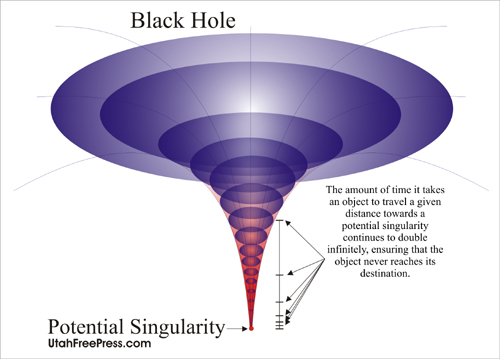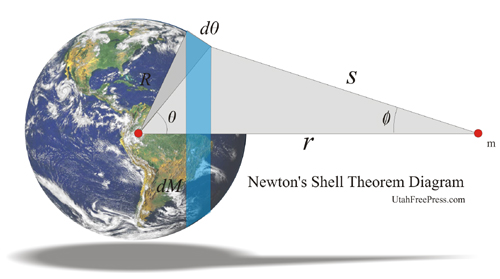This morning I woke up and decided that I was going to depart from my regular political rants and instead I am going to challenge Einstein and one of his long standing, widely held ideas concerning black holes. You see, Einstein predicted that inside a black hole, there would be so much mass concentrated down into a space so small that at this single point; both mass and gravity would become infinite. Einstein called this point the Singularity. For some time now I have been batting around in my head two problems regarding the existence of such a single point of infinite mass and gravity.
First, it is important to stress that I am not a physicist. I am however a thinker that loves to twist ideas from various sources around in my head; …and I am smarter than the average Yogi the Bear! As such, I am going to present the following ideas.
Problem 1: Gravity and Time
I am going to claim that Einstein’s idea of a singularity at the center of every black hole cannot exist. My reason for this is simple and has to do with time. Any physicist will tell you that gravity effects time. The more massive an object is, the more it slows time down; even to the point that time almost stops completely. I am proposing that much like time becomes the “protector” of the speed of light, so does it protect the very fabric of space by insuring that a singularity never forms within a super massive object. In a recent new television program, “Into the Universe with Steven Hawking” the renowned physicist, Steven Hawking gave a great description for how time is able to place a speed (of light) limit on every object. While I have heard this concept described in many different ways, Mr. Hawking’s description is simple and straight forward. Hawking proposed that we imagine a train traveling at as close to the speed of light as possible, 99.9% the speed of light. He then asked us to imagine what would happen if one of the passengers, a small girl sitting at the back of the train in this case, got up from her seat and ran down the aisle towards the front of the train. Basic intuition tells us that if the train is travelling just shy of the speed of light and the girl gets up and runs forward, her new forward speed should be added to the speed of the train and thus the little girl should be traveling faster than the speed of light. While this may sound logical, it simply is not what physicists like Mr. Hawking tell us would happen. Instead Mr. Hawking goes on to describe how the girl is never able to reach and surpass the speed of light because as she attempts to move forward, time slows down for her relative to her forward progress. As she attempts to run faster and faster, time continues to limit her by slowing down even more, thus insuring that she will never be able to reach or exceed the speed of light. I believe that something similar may be happening within super massive objects like black holes.

As matter falls towards a potential gravitational singularity at the center of a black hole, the closer it gets to the center, the longer it takes to get there; at least from our perspective as observers. Essentially, I am proposing that the time it takes for something to join a potential singularity keeps doubling infinitely and therefore the mass never joins with the potential singularity because it takes an infinite amount of time to get there. Essentially, it is not gravity that becomes infinite in a black hole but time. Physicists tell us that this journey towards a singularity only appears to take forever from the perspective of an observer on the outside, while the journey in “real time” for someone falling into a black hole only takes mere seconds after passing the Event Horizon. I would argue that it may be the singularity that is the mathematical illusion and only exists as a potential in all cases.
To prove this, I have constructed a possible experiment to show what is truly happening at or near the speed of light and in or near a singularity. To conduct this experiment, we need a few exotic things. We need a pair of quantum entanglements, a particle accelerator and a nearby Black Hole. For those not familiar with quantum entanglements, they are two particles linked together in the same quantum mechanical state. When you observe one of these particles, you can always be certain that the other particle is in the opposite state. These two possible states are often referred to as their spin but it is easier to think of them as being either positive or negative. A great way to describe this would be to imagine two quarters on a table. You use your magic quantum mechanics wand and forever join each coin to the other by some magical force. Now your friend takes one of the coins and carries it to a distant planet. If you both flip your coin into the air at the same time, catch it and reveal the result on the back of your hands, you each will reveal the opposite result. If you see heads, you can be absolutely certain that your friend’s coin toss came out tails. No matter how many times you do this, your friend will get the opposite result as you regardless of the distance between you. You get tails and he gets heads. You get heads three times in a row and he will get three tails in a row. Einstein called this phenomenon, “spooky action at a distance.” Needless to say, Einstein was not a fan of it, because it implied that there was some kind of faster than light communication.
So now imagine we have a pair of these entanglements. We keep one in our lab and stick the other in a particle accelerator. As we send or separated quantum entanglement around in circles through the accelerator and continue to check the state (flip the coin) of its pair in our lab, intuition tells us that something strange should happen as our particle in the accelerator approached 99.9% the speed of light. Time for this super-fast entangled particle should begin to radically slow down and even nearly stop. As time for our super-fast particle comes to a near stop, its “spin” should also come to a near halt. If this is the case then every time we observe its entangled pair in the lab, we should get the exact same result. If the spinning coin in the accelerator stops spinning in time and gets ‘stuck’ on say heads, then so should our lab coin repeatedly give us the result of heads. Now if we perform this same experience but instead send one of our quantum entangled coins into a black hole we should observe one of two phenomena. Either our lab coin once again gets stuck on heads as our black hole coin get stuck in time or our lab coin continues to flip normally as our ill-fated black hole coin meets its fate at the singularity. If our entangled black hole coin does get ‘stuck’ in forever freefall it should indicate that the problem for physicists where black holes seem to destroy the laws of physics as both gravity and mass become infinite simply, does not exist because the source of their problem never occurs and can only be described as a “potential singularity.”
Problem 2: Newton’s Shell Theorem
Another problem that continues to challenge my understanding of black holes has to do with Sir Isaac Newton’s Shell Theorem. Among other applications, in short, the Shell Theorem shows us that at the center of any massive body like the earth or the sun, the gravitational pull is zero. Well, it’s not truly zero; it’s just pulling in every opposite direction. The concept is rather simple. If you are standing on the earth, you have the entire mass of the earth pulling on you, beneath your feet. Now say you could take an elevator to the center of the earth. As you travel downward, you begin noticing that there is an increasing large amount of the earth not just below your feet but above your head as well. Of course, this mass above you is pulling on you gravitationally in the same way that the mass of the earth below you is pulling on you. (It may help to think of how the moon’s gravity pulls against the earth, lowering the gravity of the earth on that side slightly and allowing tides to rise.) As you get closer to the center of the earth, you begin to experience something very curious. You are getting lighter and lighter as more and more of the mass of the earth is no longer below you but above you. Once you reach the center of the earth you become perfectly weightless as all the earth is around you in every direction. It’s not that you are no longer under the influence of gravity, it just that gravity is pulling equally on you in all directions cancelling its self out.

By now you have probably guessed that I am now going to apply this same principle to black holes. While black holes are truly far more massive than the earth or even the sun for that matter, the same principals outlined in Newton’s Shell Theorem should also be applicable to black holes. Per the Shell Theorem, at the center of a black hole there should be ZERO gravity! Of course, this notion flies in the face of the common belief by physicists that gravity becomes infinite at a single point (the singularity) in the center of a black hole. I would argue that this may not be the case because once again the singularity is never able to form since no matter how hard you try, there will always be more matter behind you the closer you get to the absolute center of the black hole. I believe that this is safe to say because even at the forming of a black hole, when a massive star runs out of enough energy to hold its self up against its own gravity and collapses, there is already an area of zero gravity at the center of the collapsing star. As the mass of the star moves in on its self towards the center to form a black hole, any matter towards the center would be pulled on by the matter at the exterior and vice versa. This should lead to a kind of stasis or balance between the interior gravitational forces and the exterior gravitational forces.
If this turns out to be true, it would mean that while truly massive, a black hole is far from a tear in the fabric of space and time but merely a huge massive object that simply prevents light and other radiation from escaping (besides Hawking’s radiation that is). Rather than the mass of a black hole being concentrated down to an infinitely small point, it is likely just a swirling mass of varying densities, much like a star whose light and radiation are forever trapped in its gravitational field.
Conclusion:
There May Be No SINGULARITY!
[Originally published @ Utah Free Press dot com, October 2010]